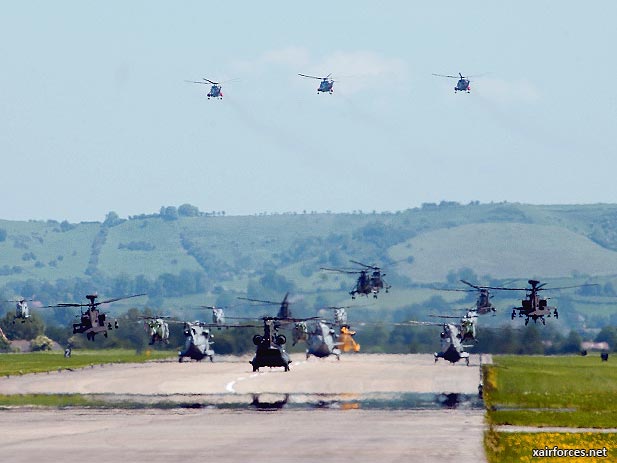
British Helicopter Engineers Overcome the Heat In Afghanistan

As daytime temperatures soar towards 50 degrees Celsius in the shade in Afghanistan the heat is on for the engineers who keep the fleet of helicopters in the air.
The tri-Service Joint Aviation Group provides rotary wing support to British and coalition forces. At Camp Bastion in Helmand province RAF Chinook and Merlin crews operate alongside colleagues from the Army Air Corps and the Fleet Air Arm flying Apache, Lynx and Sea King helicopters.
For the ground crew who keep the aircraft serviceable the extreme heat of the summer months brings with it a unique set of engineering challenges.
The Merlin HC3 helicopters of 1419 Flight are being operated by 78 Squadron's A Flight from RAF Benson:
"When we first came here last July and got off the aircraft at midnight it was like walking into an oven," said Senior Aircraftman Chris Bird. "I didn't expect it to be that hot in the middle of the night."
"The aircraft isn't specifically designed to operate in these extreme temperatures, which brings with it a whole host of engineering challenges which we don't see in the UK," said Flight Lieutenant Suzie Gray.
"For example the engines require cleaning regularly, which requires more manpower, and our other equipment can also overheat very quickly in the height of summer," continued the junior Engineering Officer.
"These helos were primarily designed for the North Sea environment and the vast amount of avionics equipment fitted does get to a phenomenal temperature out here," explained Corporal Stuart Robertson, an Avionics Technician. "The Merlin is equipped with a complex avionics suite which generates a lot of heat when in use. Couple that with the extreme temperatures and dusty environment here and the kit gets very hot."
Sensible precautions are drilled into the RAF personnel who work through the day and night, whatever the conditions:
"When an aircraft returns we have to wait for it to cool down" said Corporal Robertson.
"You take on plenty of water and keep an eye out for each other. If anyone looks like they're struggling you take them off the job immediately and take them to cool down."
"Most of our work is up around the gearbox and engines which run at temperatures of 150 degrees C plus," explained Corporal Tristan Gill.
"Even if you leave the engines for three hours they are still very warm. We therefore have to wear our sleeves down as a precaution, which in the temperatures out here can make you a tad warm.
"I normally have two guys working for me and I am therefore responsible for ensuring they take on water and do not stay in the sun too long," he added.
"Even in the hangar we have a break at least every 30 minutes which results in jobs taking twice as long to complete."
Whilst working out on the pan in the blazing sun wearing personal protective equipment is very uncomfortable, working in the cockpit where the heat is unable to escape is far worse:
"It's surreal that you have to put on more layers because of the heat," said Senior Aircraftman Bird. "The cockpit is like a greenhouse and it's not uncommon to see the pilots' temperature gauge off the 50 degrees C scale.
"When you kneel on top of the aircraft you can feel the heat through your overalls and so the trick I've learned is to tip a bottle of water over the airframe I'm working on. It evaporates instantly but it does make it slightly easier," he added.
For Flight Lieutenant Gray, who is experiencing her first HERRICK tour, the ground crew had exceeded expectations:
"The team have done absolutely brilliantly. We have some very senior guys here and have been able to deal with everything the environment has thrown at us.
"Because we've got a mixture of experience, the younger guys are mentored from day one, and as we work 12 hours on, 12 hours off, it only takes a matter of days to settle into a routine," she added.
But despite the harsh environment the RAF personnel do consider themselves to be in a fortunate position:
"The work's hard and just when you think things are going all right something else will happen," said Corporal Robertson.
"But it's satisfying to know we're making a difference and helping the troops on the front line, and we all appreciate that we're privileged to be here where we're not in any great danger."
"We're very linked in to our aircrew who tell us what they've been doing and so the engineers do get a sense of satisfaction from knowing their work is extremely valued," said Flight Lieutenant Gray.
Despite the workload 78 Squadron are finding time to raise money for charity. They have set themselves the target of travelling around the world in 60 days without the aid of transport. With an hour in the gym equating to one minute in each of 24 time zones, to accomplish their task the RAF team will need to spend a total of 1,440 hours working out.
Source: UK Ministry of Defence News - 17 July 2012
Photo: The U.K. Army Air Corps and the Fleet Air Arm flying Sea King, Lynx, Merlin, Apache and Chinook helicopters from the Royal Navy, Army and Royal Air Force prepare for the Falklands25 Anniversary flypast (Photo by LA (Phot) Paul A'Barrow)
(18.07.2012)
|